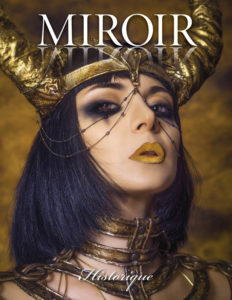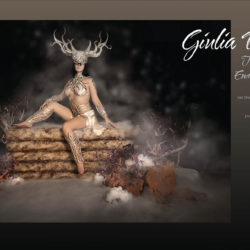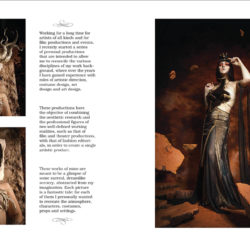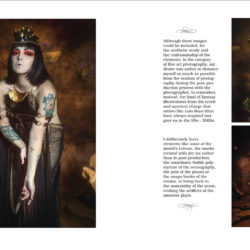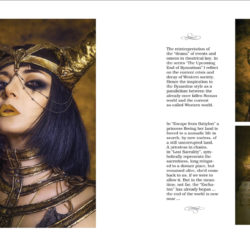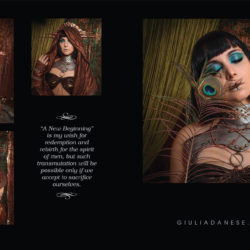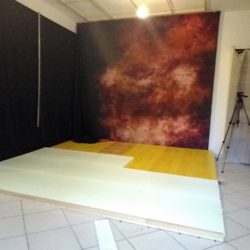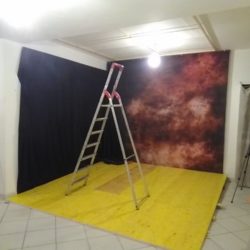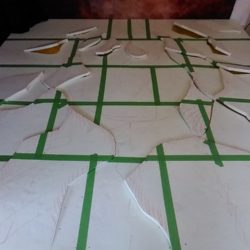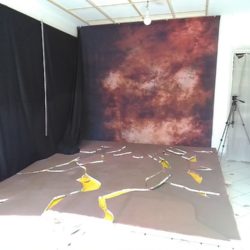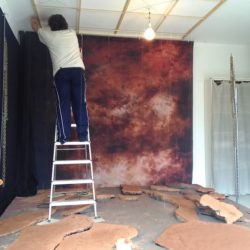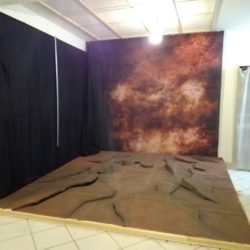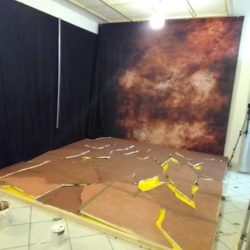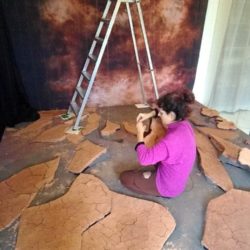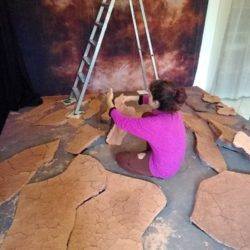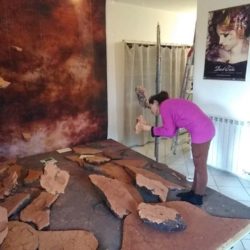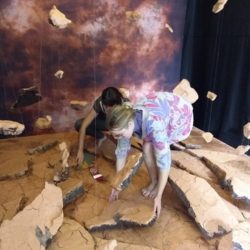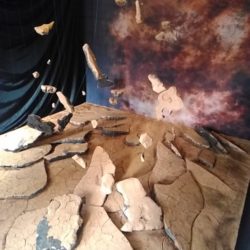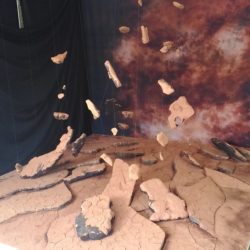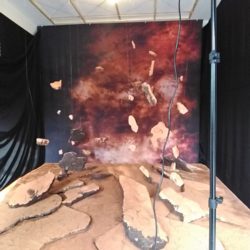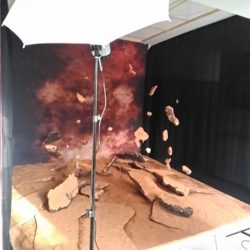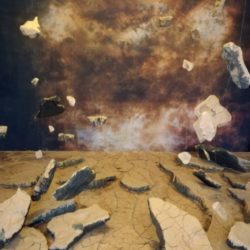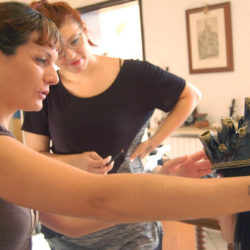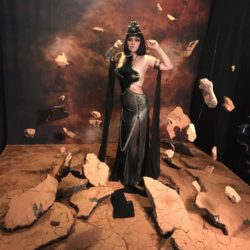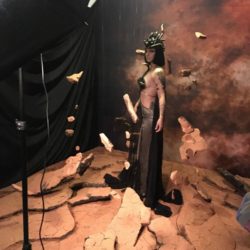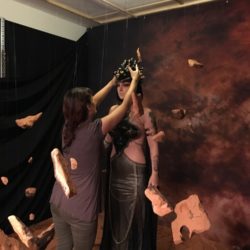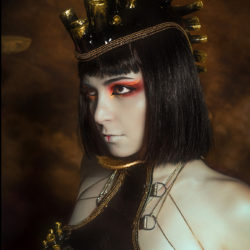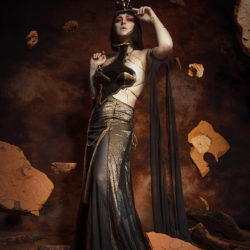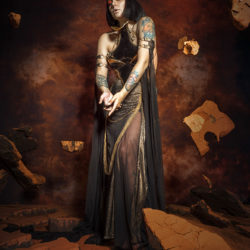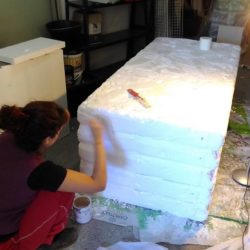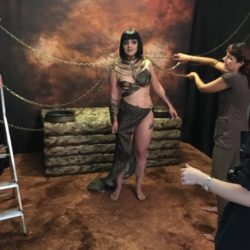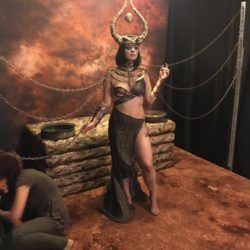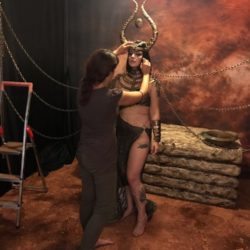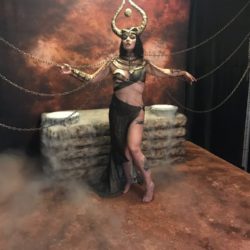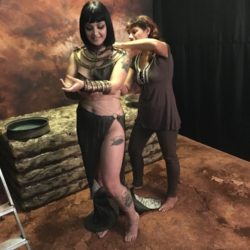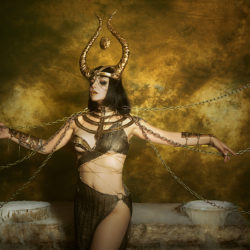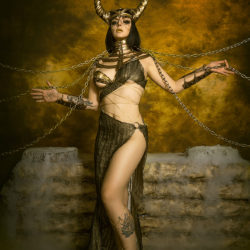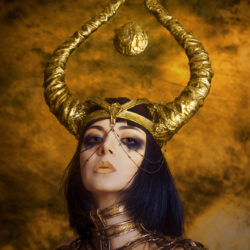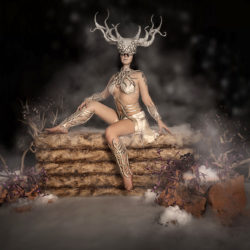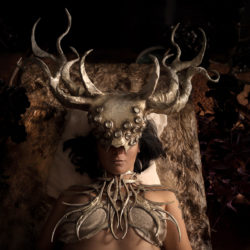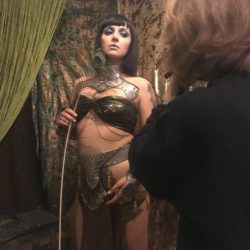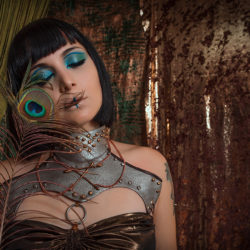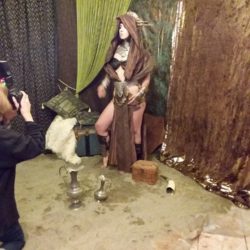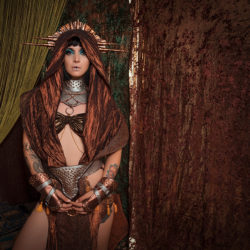The Upcoming End of Byzantium
In my series, besides create the concept, i want personally design and craft every costumes, scenography or also some props and this is a process that can take months of preparation.
For “The Upcoming End of Byzantium” my last project, in particular, it took about three months of full-time work only for preparation.
My idea for this series, originally, was a little different. The message and the sensations from which I started were similar, but initially I had imagined it in a setting with a more oriental aesthetic.
For this reason, starting to look for the model, I decided to contact Giulia. I had seen her photos and I had fallen in love with her long raven hair, which in many shots made her look like an oriental beauty, but talking to her, unfortunately, it turns out that she had just cut them… I see her photo with her new look and… no problem, a new idea immediately springs to my mind!
Her new haircut marries well with her physicality, with broad shoulders and narrow pelvis with straight sides, which immediately brought to mind the typical physicality of ancient Greek statues.
So I decide for a new mood of the series.
Furthermore her passion for deer and their symbolism not only led her to tattoo them all over her body, but also inspired her stage name “Ankthi Roe”.
Perfect then for the character of “A New Beginning” the last chapter of the project: The deer, with its multiple meanings, that can be traced back to the whole series, including that of rebirth. Hence my decision not to have the model’s tattoos removed in post production, but rather to keep them as a tribute.
So I started to work at the design of the set and the costumes.
For this series, I wanted the scenarios to be more varied to separate the characters from each other more, albeit with a common thread. This meant creating more than one set.
Moreover, the members of the team all came from different cities and this made it imperative to perform the photo shoot in a single day.
To be able to do this, it was necessary to arrive at the day of the shooting with everything ready, and everything had to be planned to work in a practical and fast way so as to be able to optimize as much as possible the little time that we would have had available.
For this reason, after several evaluations, I opted to shoot in my laboratory. I would obviously have preferred to have a larger space, rather also renting it, to have less possible design-artistic limitations but, such a project involves a lot of work with all its relative discomforts, moreover I needed a space where I could work, go and come, at all hours of the day and night for a long time, and with the possibility of having further time later, to rearrange everything after filming … as you can imagine, for a set like this, it takes days to disassemble and clean up everything.
So, using my lab was the most practical thing to do. Having to reduce the scope of the project already for reasons of space, I didn’t want to give up however to a minimum of diversification of scenarios and for this I had to get to work to create environments, which had elements of the scenes easily and quickly interchangeable in one reduced space.
It was a real challenge… first of all, wanting to simulate an open space for some characters, the background backdrop was not enough, so I wanted to help the photographer to get a minimum depth more on the image. To do this, I built a base platform for the set design, tilted with a gradation proportionate to the set and the surrounding space to create an optical effect that would give even a minimal idea of perspective.
After which, since in my productions I wish there were more real elements possible, rather than added in post-production, to bring the observer back to the materiality of the scene, I decided to use sand and real clay, attached by hand (at the expense of my back) of so that it created the natural cracks of parched earth. The order of the shots for the various characters was defined based on the possibility of transmutation that the basic scenography could get from its technical qualities.
For this the chapter of “Eschaton” was taken first. I wanted to simulate a dream-apocalyptic situation, as if the character that represented the Eschaton precisely, gave rise to a form of energy that would magnetize the earth around itself until it was smashed and fragmented into various clods that would rise floating towards the sky.
So I hung the “floating” clods with the transparent fishing line (easily removable, once their purpose had ceased, cutting the lines at the base), but instead, with regard to the large echelons of the ground that broke by tilting upwards, I had to invent an ingenious and practical system so as to be able to quickly push down it all down to get a perfect plan that could be used to stage the second character.
For the setting of “Lost Sacrality”, continuing to go back and forth, to do this job of recomposing the soil, and to stage the large altar of polystyrene and wood, the clay reacted as obviously I had already foreseen, and it crumbled creating the image and the perception of a different ground from that on which the first character was set…perfect for my purpose!
As for the background, I had already imagined leaving the one used for Eschaton mounted, and then simply changing the color in post-production, so as to differentiate the atmosphere of the scenes and to remember, in tribute, the bright colors of gold and yellow tones of some images of my favorite film “Immortals”, by Tarsem Singh, to which I was slightly inspired for this series.
To pass to the shooting of the character of “A New Beginning”, I made the transmutation of the environment minimal and simple. It was enough to change the background with a black backdrop and bring the plants to the stage, to remember the vision of an altar located in a small night garden.
The abundance of dry ice smoke would have thought of the atmosphere.
As soon as we finished working with the platform, we were able to move our things and ourselves above it, in order to free the only small corner of the free room of my studio, which was the one we were in during the execution of the shots, to unless we were hidden behind the altar, crouched down like rabbits, to add dry ice in the cauldrons between the various shots.
Obviously, I had already pre-arranged the walls of the small space , like a nomadic tent, in the days prior to the shooting, so as not to lose even more time. So to finish setting up “Escape from Babylon”, the last remaining chapter of the series, I stretched a plastic sheet on my poor floor and poured sacks of real sand over it. Once the props were staged, the last set was ready too!
At the end of the day, we were all exhausted to say the least, and in the following days, it took me almost a week just to dismantle the sets, clean everything, and to finally riappropiate me of my lab… but it was definitely another more adventure that I can tell!
Interview with Giulia Danese
Q: Tell us about your art and what inspired you to produce imagery with a historic theme or elements from the past.
A: Working for a long time for artists of all kinds and for film productions and events, I recently started a series of personal productions that are intended to allow me to reconcile the various disciplines of my work background, where over the years I have gained experience with roles of artistic direction, costume designer, set designer and art designer. These productions have the objective of combining the aesthetic research and the professional figures of two well-defined working realities, such as that of film and theater productions, with that of fashion magazines, in order to create a single artistic product. These works of mine are meant to be a glimpse of some unreal, dreamlike scenery, abstracted from my imagination and for each of them I personally wanted to recreate atmosphere, characters, costumes, props and scenography. My passion has always been to create epic characters and dreamlike scenery.
I have always loved both true stories and the myths and legends that tell of the epic deeds of heroes and heroines. I believe that the profound beauty in the strength that resides in the “Maximum Sacrifice” of the Hero even with the most dramatic and unfortunate end, is the only true form of pure Beauty and Unconditional Love that can be created by the human being.
I am moreover attracted to feminine aesthetics, to the depiction of divinities and martyrs in Sacred Art and to everything that is mystical, mysterious and powerful and fortunately I do a job that allows me to introduce, mix and rework, all of these influences that fascinate me in all my creations.
Working mainly as a Costume Designer, I am used to telling the characters and their stories through the shapes and colors of the clothes and the design; in this work, as in Visual Arts, it is essential to know and be inspired by the customs and traditions of the different eras of the past. This serves both, where required, to remain correctly pertinent to the historical period in which the show, the film or the photoshoot to which one is working is set, both, as in this case, to create a deliberately eclectic and evocative design in order to tell new stories and characters. I am always fascinated to see how working together colors, costumes and scenography on a set or a stage is similar to creating a painting.
Q: Is there anyone who has strongly influenced your style or direction in art? Or is there any artist from the past which inspires your art in any way whom you wish to mention?
A: Yes sure, I grew up in the 80s and 90s in Italy, where the images of the heroines from the strong erotic and mystical charge of Luis Royo raged and on TV we began to see for the first time sagas with really innovative messages and themes such as: Mad Max, Fantaghirò, Xena: Warrior Princess, Buffy the Vampire Slayer, etc… in which the women were sexy warriors and heroines but were also very strong psychologically and physically; despite today, perhaps even due to the hegemony of the Me Too movement, the Big Productions want impose on us the feminism, inappropriately as an innovation.
My art has certainly been influenced by this, but there are also contemporary artists, from the most various disciplines, whom I respect and admire very much and from whom I constantly draw inspiration, such as: Dave McKean, the sadly passed away Alexander McQueen, Tim Walker, David LaChapelle, H.R. Giger and the great directors Guillermo del Toro and Tarsem Singh the creator of the magnificent artwork “Immortals”, to which I was strongly inspired for this my last project. If I had to look to a much more distant past, obviously all the artists of art history have their own influence, but Hieronymus Bosch and Gustav Klimt remain among my favorites of all time.
Q: Are you formally trained or self taught? Tell us about your path as an artist.
A: To be honest, both things. I graduated in Decoration at the Ligurian Academy of Fine Arts (Accademia Ligustica di Belle Arti) in Genoa and consequently I took a Specialization Diploma in Fashion Design and Dressmaking, but this happened only after that I had already worked in the artisan fashion sector for a few years, so it was just a way to deepen my knowledge on the subject rather than learn all from the beginning.
Then it was the technical mastery acquired over the years, working in all field of the clothing and costume manufacturing process and the artistic experiences gained in fields such as dance, painting and acting, which allowed me to have a complete vision and management of the different artistic departments in the field of performing arts and cinematography.
Q: Tell us a little about your preferred medium and technique, do you have any favorite products or applications?
A: Personally I think that the best results, in everything, are always obtained by mixing different materials and / or techniques.
Moreover, over the years, I have experimented with different combinations and techniques, and I can say with certainty that it is usually the cheapest materials and products that give the greatest satisfaction. Everything is in knowing how to dose them, mix them and apply them to each other.
Q: Are there any stories, fairytales, or histories which have made a significant impression on you as an individual or as an artist?
A: There are many stories about folklore, fairytales, and epic and chivalrous poems that have profoundly marked me since I first read them as a child, but it can be said that, in contemporary literature, Neil Gaiman is the only one with the capacity to impressed me yet with an unrestrained (and by now rare) fantasy, enchanting me with his stories. His narrative is sometimes so poetic that it amazes me to the point of emotion… only those who have read “Neverwhere” or “Stardust”, my two favorites among his most famous novels, can understand what kind of poetry I refer to!
Q: Do you feel that we can find lessons in our past which might give reason to our present? (As in history repeats itself).
A: I don’t think history really repeat itself, but I think we have a lot of difficulty to reckon with it, and recognizing some fundamental aspects of our nature; these two aspects make us bad students at the lessons that history tries to teach to us.
Of important lessons, for the present that we are experiencing, there would be many; just to give an example, I am thinking of Easter Island, whose history is quite emblematic of what happens when exploiting an environment beyond its capacity for recovery.
We have the advantage of knowing to what our actions will lead to, but it does not seem that we really care and we continue with our lifestyle as if we were unaware.
What I want to say is that in our history it has already happened that we allowed that the technological, artistic, philological and political progress slip from our fingers and this has led us to the dark ages, such as the medieval one, which lasted for centuries and from which we made an enormous effort to get out.
The starting situation at that time was different, since while before, the effects of the fall of a civilization did not necessarily have repercussions on another, today instead, since we are globalized, the repercussions of any mistake are spread over the whole world in an amplified way… and this unfortunately puts us in a decidedly more dangerous and precarious situation…
Q: Do you research or study the past for inspiration, if so what are some of your favorite time periods, places or cultures?
A: To create an “open” and consequently eclectic style, I obviously have to be able to draw inspiration from as many historical periods as possible, but I admit I have a weakness for Hellenic, Roman and late medieval cultures.
Q: If you could visit the past what era would you return to and why?
A: I don’t know… surely I wouldn’t choose any particularly difficult or dangerous period, I’m not so adventurous… Maybe instead, I would simply limit myself to going back to the mythical 60s, just to enjoy the famous climate of “change and trust in the be able to get a better world”, of which he still remembers those who has lived that period. For those born of my generation onwards, even the simple hope that this happens is pure utopia. So it would be nice to be able to bask even for a moment in that feeling, albeit ephemeral.
Q: What do you feel is the artists role in society, for example, as an artist, do you feel that you have an obligation to bring awareness to certain issues which might have a greater impact visually than a verbal account might have? Or do you feel that art is non-political? Is its sole purpose to inspire, or be decorative, or is the hope to get a reaction?
A: I believe that the real Art, by its very nature, should arouse emotions, but I think also that it would be a serious mistake to try to use its communication skills only for the purpose of educational indoctrination.
Art is pure expression, and as such, above all things must be left free. Even just expressing itself. If then, through it, we can also give a positive contribution to the world and the society, all the better for us!
Q: If you could meet any artist from the past who would it be and why?
A: Without going too far back in time, I think I would like to meet the Japanese art director, costume designer, and graphic designer Eiko Ishioka. During his multi-faceted career she also won an Oscar as Costume Designer for “Dracula” by Francis Ford Coppola and she had the honor of working closely for one of my favorite directors, Tarsem Singh, for as many as four of the most wonderful productions ever released: The Cell, The Fall, Immortals, and Mirror Mirror.
I would like to ask her if it was a her actual and considered choice, not to devote her working career entirely to the field of costume design due to inexorable love for the other disciplines, or if she simply did not find conform, with her lifestyle, certain mechanisms that are established in the high spheres of the film industry.
Q: What advice do you have for artists just starting out?
A: I strongly advise them to learn as many skills as possible in different artistic disciplines, in the most varied artistic / craft fields. This will allow them to earn their living, remaining however in an artistic ambit, and therefore continuing to accumulate experience in this sector, waiting to find a job opportunity more suited to their own specialization and their own inclinations.
Q: If you had full funding for any project, what would it be?
A: Well, wow… it’s from a lifetime that my secret dream would be to set up a theatrical production of the “Pinocchio” fairy tale, represented however in a Dark Key, which then would be the most appropriate interpretation of the original story by Carlo Collodi, with those atmospheres and characters so dark and with its such dramatic implications.
At the same time, I have been studying a project for a couple of years, which would require considerable energy and funding … Near an inland village in the area where I live, there are the ancient remains of a huge church now without a roof from an infinite amount of time.
When you enter inside it, the visual impact is of an impressive magnificence. Its walls, like an amphitheater, stand out, and at the same time embrace the sky, creating a strange optical effect like that of the wide-angle lens, which would make it a suggestive set for any type of show.
My idea would be to create several huge living installations in it, to be immortalized obviously on several occasions, using a multitude of dancers ‘and actors’ bodies, subjected to “body painting”, to create immense shapes / compositions, on which to impose a subject that dominates the scene from above, so thus creating situations with an epic atmosphere.
Q: Are there any projects in the making you would like to share with us?
A: Yes, right now I’m working on several projects, including the realization of some costumes very scenographically and choreographic , made with recycled materials, to which, the dancers’ performances, will suited very well and some sculpture costumes, made of wood, metal and natural materials, to subject them to the bad weather and the four elements, inducing and experimenting with decorative shapes, such as rust or mushrooms and moss… It’s still early to talk about it, because I’m still in the experimental phase, but I’m really curious to see what comes out!
Q: If you were to attribute any emotional, spiritual, or physical context to your art, what would it be? Is there a story behind the image, a feeling, a dream or belief?
A: Certainly, the project I would like to show you in this edition of Miroir Magazine, my new series entitled “The Upcoming End of Byzantium”, like others, has naturally had its own study and its planning and there is a meaning behind every design choice.
Although these images could be included, for the aesthetic study and the craftsmanship of the elements, in the category of fine art photography, my desire was rather to distance myself as much as possible from the realism of photography during the post-production process with the photographer, to remember, instead, the kind of fantasy illustrations that artists like Luis Royo gave us in the 90s – 2000s. I deliberately leave elements like some of the model’s tattoos, the smoke created with dry ice rather than in post-production, the sometimes visible polystyrene of the scenography, the pots of the plants or the snaps-hooks of the chains, for bring back us to the materiality of the scene, evoking the artifices of the amateur plays.The reinterpretation of the “drama” of events and omens in theatrical key. In the series “The Upcoming End of Byzantium” I reflect on the current crisis and decay of Western society. Hence the inspiration to the Byzantine style as a parallelism between the already oncefallen Roman world and the current so-called Western world.
In “Escape from Babylon” a princess fleeing her land is forced to a nomadic life in search, by now useless, of a still uncorrupted land.
A priestess in chains, in “Lost Sacrality”, symbolically represents the sacredness, long relegated to a distant place, but remained alive, she’d come back to us, if we were to allow it.But in the meantime, not far, the “Eschaton” has already begun, the end of the world is now near…
“A New Beginning” is my wish for redemption and rebirth for the spirit of the men, but such transmutation will be possible only if we accept to sacrifice ourselves.
Giulia Danese’s website:
www.giuliadanese.com
Social pages:
www.instagram.com/giulia.danese.designer
www.facebook.com/Giulia.Danese.Costume.Designer



